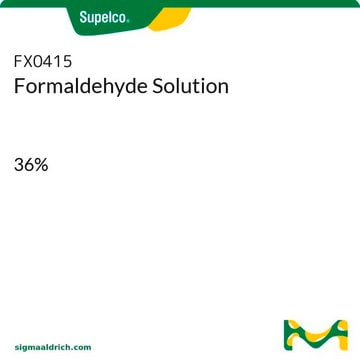47608
Formaldéhyde solution
for molecular biology, BioReagent, ≥36.0% in H2O (T)
Synonyme(s) :
Formol
About This Item
Produits recommandés
Qualité
for molecular biology
Niveau de qualité
Densité de vapeur
1.03 (vs air)
Pression de vapeur
52 mmHg ( 37 °C)
Gamme de produits
BioReagent
Forme
liquid
Température d'inflammation spontanée
572 °F
Contient
~10% methanol as stabilizer
Concentration
≥36.0% in H2O (T)
36.0-38.0% (aldehyde method)
Technique(s)
electrophoresis: suitable
Impuretés
≤0.03% free acid (as HCOOH)
Résidus de calcination
≤0.05% (as SO4)
pH
2.8-4.0
Densité
1.09 g/mL at 20 °C
1.09 g/mL at 25 °C (lit.)
Traces d'anions
chloride (Cl-): ≤10 mg/kg
sulfate (SO42-): ≤20 mg/kg
Traces de cations
Ca: ≤5 mg/kg
Cd: ≤1 mg/kg
Co: ≤1 mg/kg
Cr: ≤1 mg/kg
Cu: ≤1 mg/kg
Fe: ≤1 mg/kg
K: ≤20 mg/kg
Mg: ≤1 mg/kg
Mn: ≤1 mg/kg
Na: ≤100 mg/kg
Ni: ≤1 mg/kg
Pb: ≤1 mg/kg
Zn: ≤1 mg/mL
λ
2 M in H2O
Absorption UV
λ: 260 nm Amax: 0.01
λ: 280 nm Amax: 0.01
Adéquation
in accordance for electrophoresis of RNA in agarose gels
Température de stockage
room temp
Chaîne SMILES
[H]C([H])=O
InChI
1S/CH2O/c1-2/h1H2
Clé InChI
WSFSSNUMVMOOMR-UHFFFAOYSA-N
Vous recherchez des produits similaires ? Visite Guide de comparaison des produits
Description générale
It is an aliphatic aldehyde that is widely used in industrial applications for the synthesis of several chemicals such as melamine formaldehyde, urea-formaldehyde, phenol formaldehyde and industrial resins, paraformaldehyde, polyols, chelating agents, slow release fertilizers, 1,4-butanediol and hexamethylenetetramine.
Application
- denaturation and separation of RNA molecules
- anti-bacterial treatment
- fixation of cells
- in the fixation of human spermatogonial stem cell transplantation (SSCT).
- to crosslink T- cell acute lymphoblastic leukemia protein/DNA complex during chromatin immunoprecipitation.
- in fixing zebra fish larvae for neutrophil staining.
Attention
Principe
Mention d'avertissement
Danger
Mentions de danger
Classification des risques
Acute Tox. 2 Inhalation - Acute Tox. 3 Dermal - Acute Tox. 3 Oral - Carc. 1B - Eye Dam. 1 - Flam. Liq. 3 - Muta. 2 - Skin Corr. 1B - Skin Sens. 1 - STOT SE 1 - STOT SE 3
Organes cibles
Eyes,Central nervous system, Respiratory system
Code de la classe de stockage
3 - Flammable liquids
Classe de danger pour l'eau (WGK)
WGK 3
Point d'éclair (°F)
133.0 °F - closed cup
Point d'éclair (°C)
56.11 °C - closed cup
Équipement de protection individuelle
Faceshields, Gloves, Goggles, type ABEK (EN14387) respirator filter
Certificats d'analyse (COA)
Recherchez un Certificats d'analyse (COA) en saisissant le numéro de lot du produit. Les numéros de lot figurent sur l'étiquette du produit après les mots "Lot" ou "Batch".
Déjà en possession de ce produit ?
Retrouvez la documentation relative aux produits que vous avez récemment achetés dans la Bibliothèque de documents.
Les clients ont également consulté
Notre équipe de scientifiques dispose d'une expérience dans tous les secteurs de la recherche, notamment en sciences de la vie, science des matériaux, synthèse chimique, chromatographie, analyse et dans de nombreux autres domaines..
Contacter notre Service technique












